Cloud Computing
Understanding Cloud Computing
Vulnerabilities
Discussions about cloud computing security often fail
to distinguish general issues from cloud-specific issues.
To clarify the discussions regarding vulnerabilities, the
authors define indicators based on sound definitions of
risk factors and cloud computing.
Bernd
GroBauer,
ToBias
Walloschek,
and elmar
sTöcker
Siemens
E ach day, a fresh news item, blog entry, or other
publication warns us about cloud computing’s
security risks and threats; in most cases, secu-
rity is cited as the most substantial roadblock
for cloud computing uptake. But this discourse about
cloud computing security issues makes it difficult to
formulate a well-founded assessment of the actual se-
curity impact for two key reasons. First, in many of
these discussions about risk, basic vocabulary terms—
including risk, threat, and vulnerability—are often used
interchangeably, without regard to their respective
definitions. Second, not every issue raised is specific
to cloud computing.
To achieve a well-founded understanding of the
“delta” that cloud computing adds with respect to se-
curity issues, we must analyze how cloud computing
influences established security issues. A key factor here
is security vulnerabilities: cloud computing makes cer-
tain well-understood vulnerabilities more significant
as well as adds new ones to the mix. Before we take a
closer look at cloud-specific vulnerabilities, however,
we must first establish what a “vulnerability” really is.
Vulnerability: An Overview
Vulnerability is a prominent factor of risk. ISO 27005
defines risk as “the potential that a given threat will
exploit vulnerabilities of an asset or group of assets and
thereby cause harm to the organization,” measuring it
in terms of both the likelihood of an event and its con-
sequence.1 The Open Group’s risk taxonomy (www.
opengroup.org/onlinepubs/9699919899/toc.pdf) of-
fers a useful overview of risk factors (see Figure 1).
The Open
Group’s taxono-
my uses the same
two
top-level
risk factors as ISO 27005: the likelihood of a harm-
ful event (here, loss event frequency) and its consequence
(here, probable loss magnitude).1 The probable loss mag-
nitude’s subfactors (on the right in Figure 1) influence a
harmful event’s ultimate cost. The loss event frequen-
cy subfactors (on the left) are a bit more complicated. A
loss event occurs when a threat agent (such as a hacker)
successfully exploits a vulnerability. The frequency
with which this happens depends on two factors:
• The frequency with which threat agents try to ex-
ploit a vulnerability. This frequency is determined
by both the agents’ motivation (What can they gain
with an attack? How much effort does it take? What
is the risk for the attackers?) and how much access
(“contact”) the agents have to the attack targets.
• The difference between the threat agents’ attack ca-
pabilities and the system’s strength to resist the attack.
This second factor brings us toward a useful defini-
tion of vulnerability.
Defining Vulnerability
According to the Open Group’s risk taxonomy,
Vulnerability is the probability that an asset will be
unable to resist the actions of a threat agent. Vulner-
ability exists when there is a difference between the
50
COPUBLISHED BY THE IEEE COMPUTER AND RELIABILITY SOCIETIES
1540-7993/11/$26.00 © 2011 IEEE
MARCH/APRIL 2011
�
Control strength
Threat capacity
Vulnerability
Risk
Random
Regular
International
Asset value
Level of effort
Risk
Contact
Action
Loss event
frequency
Probable
loss
magnitude
Threat event
frequency
Cloud Computing
Embarrassment
Competitive
advantage
Legal/regulatory
General
Productivity
Sensitivity
Cost
Access
Misuse
Disclose
Modify
Deny access
Containment
Remediation
Recovery
Asset loss
Primary
loss factors
Value
Volume
Competence
Threat loss
Action
Internal vs.
external
Timing
Organizational
Due diligence
Secondary
loss factors
External
Response
Detection
Detection
Legal & regulatory
Competitors
Media
Stakeholders
Figure 1. Factors contributing to risk according to the Open Group’s risk taxonomy. Risk corresponds to the product of loss event frequency
(left) and probable loss magnitude (right). Vulnerabilities influence the loss event frequency.
force being applied by the threat agent, and an ob-
ject’s ability to resist that force.
So, vulnerability must always be described in terms
of resistance to a certain type of attack. To provide
a real-world example, a car’s inability to protect its
driver against injury when hit frontally by a truck
driving 60 mph is a vulnerability; the resistance of the
car’s crumple zone is simply too weak compared to
the truck’s force. Against the “attack” of a biker, or
even a small car driving at a more moderate speed, the
car’s resistance strength is perfectly adequate.
We can also describe computer vulnerability—that
is, security-related bugs that you close with vendor-
provided patches—as a weakening or removal of a
certain resistance strength. A buffer-overflow vulner-
ability, for example, weakens the system’s resistance
to arbitrary code execution. Whether attackers can
exploit this vulnerability depends on their capabilities.
Vulnerabilities and Cloud Risk
We’ll now examine how cloud computing influences
the risk factors in Figure 1, starting with the right-
hand side of the risk factor tree.
From a cloud customer perspective, the right-
hand side dealing with probable magnitude of future
loss isn’t changed at all by cloud computing: the con-
sequences and ultimate cost of, say, a confidentiality
breach, is exactly the same regardless of whether the
data breach occurred within a cloud or a conven-
tional IT infrastructure. For a cloud service provider,
things look somewhat different: because cloud com-
puting systems were previously separated on the same
infrastructure, a loss event could entail a consider-
ably larger impact. But this fact is easily grasped and
incorporated into a risk assessment: no conceptual
work for adapting impact analysis to cloud comput-
ing seems necessary.
So, we must search for changes on Figure 1’s left-
hand side—the loss event frequency. Cloud comput-
ing could change the probability of a harmful event’s
occurrence. As we show later, cloud computing causes
significant changes in the vulnerability factor. Of
course, moving to a cloud infrastructure might change
the attackers’ access level and motivation, as well as the
effort and risk—a fact that must be considered as future
work. But, for supporting a cloud-specific risk assess-
ment, it seems most profitable to start by examining
the exact nature of cloud-specific vulnerabilities.
Cloud Computing
Is there such a thing as a “cloud-specific” vulnerabil-
ity? If so, certain factors in cloud computing’s nature
must make a vulnerability cloud-specific.
Essentially, cloud computing combines known
technologies (such as virtualization) in ingenious ways
to provide IT services “from the conveyor belt” us-
ing economies of scale. We’ll now look closer at what
the core technologies are and which characteristics of
their use in cloud computing are essential.
Core Cloud Computing Technologies
Cloud computing builds heavily on capabilities avail-
able through several core technologies:
• Web applications and services. Software as a service
www.computer.org/security
51
�
Cloud Computing
(SaaS) and platform as a service (PaaS) are unthink-
able without Web application and Web services
technologies: SaaS offerings are typically imple-
mented as Web applications, while PaaS offerings
provide development and runtime environments for
Web applications and services. For infrastructure as
a service (IaaS) offerings, administrators typically
implement associated services and APIs, such as the
management access for customers, using Web ap-
plication/service technologies.
• Virtualization IaaS offerings. These technologies have
virtualization techniques at their very heart; because
PaaS and SaaS services are usually built on top of
a supporting IaaS infrastructure, the importance of
virtualization also extends to these service models.
In the future, we expect virtualization to develop
from virtualized servers toward computational re-
sources that can be used more readily for executing
SaaS services.
• Cryptography. Many cloud computing security re-
quirements are solvable only by using cryptographic
techniques.
As cloud computing develops, the list of core tech-
nologies is likely to expand.
Essential Characteristics
In its description of essential cloud characteristics,2 the
US National Institute of Standards and Technology
(NIST) captures well what it means to provide IT ser-
vices from the conveyor belt using economies of scale:
• On-demand self-service. Users can order and manage
services without human interaction with the ser-
vice provider, using, for example, a Web portal and
management interface. Provisioning and de-provi-
sioning of services and associated resources occur
automatically at the provider.
• Ubiquitous network access. Cloud services are accessed
via the network (usually the Internet), using stan-
dard mechanisms and protocols.
• Resource pooling. Computing resources used to pro-
vide the cloud service are realized using a homo-
geneous infrastructure that’s shared between all
service users.
• Rapid elasticity. Resources can be scaled up and down
rapidly and elastically.
• Measured service. Resource/service usage is constantly
metered, supporting optimization of resource usage,
usage reporting to the customer, and pay-as-you-go
business models.
NIST’s definition framework for cloud computing with
its list of essential characteristics has by now evolved into
the de facto standard for defining cloud computing.
Cloud-Specific Vulnerabilities
Based on the abstract view of cloud computing we
presented earlier, we can now move toward a defini-
tion of what constitutes a cloud-specific vulnerability.
A vulnerability is cloud specific if it
• is intrinsic to or prevalent in a core cloud computing
technology,
• has its root cause in one of NIST’s essential cloud
characteristics,
• is caused when cloud innovations make tried-and-
tested security controls difficult or impossible to
implement, or
• is prevalent in established state-of-the-art cloud
offerings.
We now examine each of these four indicators.
Core-Technology Vulnerabilities
Cloud computing’s core technologies—Web applica-
tions and services, virtualization, and cryptography—
have vulnerabilities that are either intrinsic to the
technology or prevalent in the technology’s state-of-
the-art implementations. Three examples of such vul-
nerabilities are virtual machine escape, session riding
and hijacking, and insecure or obsolete cryptography.
First, the possibility that an attacker might success-
fully escape from a virtualized environment lies in
virtualization’s very nature. Hence, we must consider
this vulnerability as intrinsic to virtualization and
highly relevant to cloud computing.
Second, Web application technologies must over-
come the problem that, by design, the HTTP proto-
col is a stateless protocol, whereas Web applications
require some notion of session state. Many techniques
implement session handling and—as any security pro-
fessional knowledgeable in Web application security
will testify—many session handling implementations
are vulnerable to session riding and session hijack-
ing. Whether session riding/hijacking vulnerabilities
are intrinsic to Web application technologies or are
“only” prevalent in many current implementations is
arguable; in any case, such vulnerabilities are certainly
relevant for cloud computing.
Finally, cryptoanalysis advances can render any
cryptographic mechanism or algorithm insecure as
novel methods of breaking them are discovered. It’s
even more common to find crucial flaws in crypto-
graphic algorithm implementations, which can turn
strong encryption into weak encryption (or sometimes
no encryption at all). Because broad uptake of cloud
computing is unthinkable without the use of cryptog-
raphy to protect data confidentiality and integrity in
the cloud, insecure or obsolete cryptography vulner-
abilities are highly relevant for cloud computing.
52
IEEE SECURITY & PRIVACY
MARCH/APRIL 2011
�
Cloud Computing
Essential Cloud
Characteristic Vulnerabilities
As we noted earlier, NIST describes five essential
cloud characteristics: on-demand self-service, ubiqui-
tous network access, resource pooling, rapid elasticity,
and measured service.
Following are examples of vulnerabilities with
root causes in one or more of these characteristics:
• Unauthorized access to management interface. The cloud
characteristic on-demand self-service requires a
management interface that’s accessible to cloud ser-
vice users. Unauthorized access to the management
interface is therefore an especially relevant vulner-
ability for cloud systems: the probability that unau-
thorized access could occur is much higher than for
traditional systems where the management func-
tionality is accessible only to a few administrators.
• Internet protocol vulnerabilities. The cloud characteristic
ubiquitous network access means that cloud services
are accessed via network using standard protocols.
In most cases, this network is the Internet, which
must be considered untrusted. Internet protocol
vulnerabilities—such as vulnerabilities that allow
man-in-the-middle attacks—are therefore relevant
for cloud computing.
• Data recovery vulnerability. The cloud characteristics of
pooling and elasticity entail that resources allocated
to one user will be reallocated to a different user
at a later time. For memory or storage resources, it
might therefore be possible to recover data written
by a previous user.
• Metering and billing evasion. The cloud characteristic
of measured service means that any cloud service
has a metering capability at an abstraction level ap-
propriate to the service type (such as storage, pro-
cessing, and active user accounts). Metering data is
used to optimize service delivery as well as billing.
Relevant vulnerabilities include metering and bill-
ing data manipulation and billing evasion.
Thus, we can leverage NIST’s well-founded defi-
nition of cloud computing in reasoning about cloud
computing issues.
Defects in Known Security Controls
Vulnerabilities in standard security controls must be
considered cloud specific if cloud innovations directly
cause the difficulties in implementing the controls.
Such vulnerabilities are also known as control challenges.
Here, we treat three examples of such control chal-
lenges. First, virtualized networks offer insufficient net-
work-based controls. Given the nature of cloud services,
the administrative access to IaaS network infrastructure
and the ability to tailor network infrastructure are typi-
cally limited; hence, standard controls such as IP-based
network zoning can’t be applied. Also, standard tech-
niques such as network-based vulnerability scanning
are usually forbidden by IaaS providers because, for
example, friendly scans can’t be distinguished from at-
tacker activity. Finally, technologies such as virtualiza-
tion mean that network traffic occurs on both real and
virtual networks, such as when two virtual machine en-
vironments (VMEs) hosted on the same server commu-
nicate. Such issues constitute a control challenge because
tried and tested network-level security controls might
not work in a given cloud environment.
The second challenge is in poor key management
procedures. As noted in a recent European Network
and Information Security Agency study,3 cloud com-
puting infrastructures require management and stor-
age of many different kinds of keys. Because virtual
machines don’t have a fixed hardware infrastructure
and cloud-based content is often geographically dis-
tributed, it’s more difficult to apply standard con-
trols—such as hardware security module (HSM)
storage—to keys on cloud infrastructures.
Finally, security metrics aren’t adapted to cloud
infrastructures. Currently, there are no standardized
cloud-specific security metrics that cloud customers
can use to monitor the security status of their cloud
resources. Until such standard security metrics are de-
veloped and implemented, controls for security assess-
ment, audit, and accountability are more difficult and
costly, and might even be impossible to employ.
Prevalent Vulnerabilities
in State-of-the-Art Cloud Offerings
Although cloud computing is relatively young, there are
already myriad cloud offerings on the market. Hence,
we can complement the three cloud-specific vulnerabil-
ity indicators presented earlier with a forth, empirical
indicator: if a vulnerability is prevalent in state-of-the-
art cloud offerings, it must be regarded as cloud-specific.
Examples of such vulnerabilities include injection vul-
nerabilities and weak authentication schemes.
Injection vulnerabilities are exploited by manipu-
lating service or application inputs to interpret and
execute parts of them against the programmer’s in-
tentions. Examples of injection vulnerabilities include
• SQL injection, in which the input contains SQL
code that’s erroneously executed in the database
back end;
• command injection, in which the input contains
commands that are erroneously executed via the
OS; and
• cross-site scripting, in which the input contains
JavaScript code that’s erroneously executed by a vic-
tim’s browser.
www.computer.org/security
53
�
Cloud Computing
User
Front end
Network
Cloud (Web) applications
Cloud software environment
Computational
resources
Storage Communication
SaaS
PaaS
IaaS
Cloud software infrastructure
Kernel (OS/apps)
Hardware
Facilities
Service customer
Cloud-specic infrastructure
Supporting (IT) infrastructure
s
I
P
A
&
i
s
e
c
v
r
e
S
s
s
e
c
c
a
t
n
e
m
e
g
a
n
a
M
s
m
s
i
n
a
h
c
e
m
A
A
A
I
i
r
e
d
v
o
r
P
Figure 2. The cloud reference architecture. We map cloud-specific
vulnerabilities to components of this reference architecture, which gives us an
overview of which vulnerabilities might be relevant for a given cloud service.
In addition, many widely used authentication
mechanisms are weak. For example, usernames and
passwords for authentication are weak due to
• insecure user behavior (choosing weak passwords,
reusing passwords, and so on), and
• inherent limitations of one-factor authentication
mechanisms.
Also, the authentication mechanisms’ implementa-
tion might have weaknesses and allow, for example,
credential interception and replay. The majority of
Web applications in current state-of-the-art cloud
services employ usernames and passwords as authenti-
cation mechanism.
Architectural Components
and Vulnerabilities
Cloud service models are commonly divided into SaaS,
PaaS, and IaaS, and each model influences the vulner-
abilities exhibited by a given cloud infrastructure. It’s
helpful to add more structure to the service model
stacks: Figure 2 shows a cloud reference architecture
that makes the most important security-relevant cloud
components explicit and provides an abstract overview
of cloud computing for security issue analysis.
The reference architecture is based on work carried
out at the University of California, Los Angeles, and
IBM.4 It inherits the layered approach in that layers can
encompass one or more service components. Here, we
use “service” in the broad sense of providing something
that might be both material (such as shelter, power, and
hardware) and immaterial (such as a runtime environ-
ment). For two layers, the cloud software environment
and the cloud software infrastructure, the model makes
the layers’ three main service components—computa-
tion, storage, and communication—explicit. Top lay-
er services also can be implemented on layers further
down the stack, in effect skipping intermediate layers.
For example, a cloud Web application can be imple-
mented and operated in the traditional way—that is,
running on top of a standard OS without using dedi-
cated cloud software infrastructure and environment
components. Layering and compositionality imply that
the transition from providing some service or function
in-house to sourcing the service or function can take
place between any of the model’s layers.
In addition to the original model, we’ve identified
supporting functions relevant to services in several
layers and added them to the model as vertical spans
over several horizontal layers.
Our cloud reference architecture has three main
parts:
• Supporting (IT) infrastructure. These are facilities and
services common to any IT service, cloud or other-
wise. We include them in the architecture because
we want to provide the complete picture; a full
treatment of IT security must account for a cloud
service’s non-cloud-specific components.
• Cloud-specific infrastructure. These components con-
stitute the heart of a cloud service; cloud-specific
vulnerabilities and corresponding controls are typi-
cally mapped to these components.
• Cloud service consumer. Again, we include the cloud
service customer in the reference architecture because
it’s relevant to an all-encompassing security treatment.
Also, we make explicit the network that separates the
cloud service consumer from the cloud infrastructure;
the fact that access to cloud resources is carried out via
a (usually untrusted) network is one of cloud comput-
ing’s main characteristics.
Using the cloud reference architecture’s structure,
we can now run through the architecture’s compo-
nents and give examples of each component’s cloud-
specific vulnerabilities.
Cloud Software Infrastructure
and Environment
The cloud software infrastructure layer provides an abstrac-
tion level for basic IT resources that are offered as ser-
vices to higher layers: computational resources (usually
VMEs), storage, and (network) communication. These
54
IEEE SECURITY & PRIVACY
MARCH/APRIL 2011
�
services can be used individually, as is typically the case
with storage services, but they’re often bundled such
that servers are delivered with certain network con-
nectivity and (often) access to storage. This bundle,
with or without storage, is usually referred to as IaaS.
The cloud software environment layer provides servic-
es at the application platform level:
• a development and runtime environment for servic-
es and applications written in one or more supported
languages;
• storage services (a database interface rather than file
share); and
• communication infrastructure, such as Microsoft’s
Azure service bus.
Vulnerabilities in both the infrastructure and envi-
ronment layers are usually specific to one of the three
resource types provided by these two layers. However,
cross-tenant access vulnerabilities are relevant for all
three resource types. The virtual machine escape vul-
nerability we described earlier is a prime example. We
used it to demonstrate a vulnerability that’s intrinsic
to the core virtualization technology, but it can also
be seen as having its root cause in the essential char-
acteristic of resource pooling: whenever resources are
pooled, unauthorized access across resources becomes
an issue. Hence, for PaaS, where the technology to
separate different tenants (and tenant services) isn’t
necessarily based on virtualization (although that will
be increasingly true), cross-tenant access vulnerabili-
ties play an important role as well. Similarly, cloud
storage is prone to cross-tenant storage access, and
cloud communication—in the form of virtual net-
working—is prone to cross-tenant network access.
Computational Resources
A highly relevant set of computational resource vulner-
abilities concerns how virtual machine images are han-
dled: the only feasible way of providing nearly identical
server images—thus providing on-demand service for
virtual servers—is by cloning template images.
Vulnerable virtual machine template images cause
OS or application vulnerabilities to spread over many
systems. An attacker might be able to analyze config-
uration, patch level, and code in detail using admin-
istrative rights by renting a virtual server as a service
customer and thereby gaining knowledge helpful in
attacking other customers’ images. A related problem
is that an image can be taken from an untrustworthy
source, a new phenomenon brought on especially by
the emerging marketplace of virtual images for IaaS
services. In this case, an image might, for example,
have been manipulated so as to provide back-door ac-
cess for an attacker.
Cloud Computing
Data leakage by virtual machine replication is a
vulnerability that’s also rooted in the use of cloning
for providing on-demand service. Cloning leads to
data leakage problems regarding machine secrets: cer-
tain elements of an OS—such as host keys and crypto-
graphic salt values—are meant to be private to a single
host. Cloning can violate this privacy assumption.
Again, the emerging marketplace for virtual machine
images, as in Amazon EC2, leads to a related problem:
users can provide template images for other users by
turning a running image into a template. Depending
on how the image was used before creating a template
from it, it could contain data that the user doesn’t wish
to make public.
There are also control challenges here, including
those related to cryptography use. Cryptographic vul-
nerabilities due to weak random number generation
might exist if the abstraction layer between the hard-
ware and OS kernel introduced by virtualization is
problematic for generating random numbers within a
VME. Such generation requires an entropy source on
the hardware level. Virtualization might have flawed
mechanisms for tapping that entropy source, or hav-
ing several VMEs on the same host might exhaust the
available entropy, leading to weak random number
generation. As we noted earlier, this abstraction layer
also complicates the use of advanced security controls,
such as hardware security modules, possibly leading to
poor key management procedures.
Storage
In addition to data recovery vulnerability due to re-
source pooling and elasticity, there’s a related control
challenge in media sanitization, which is often hard or
impossible to implement in a cloud context. For exam-
ple, data destruction policies applicable at the end of a
life cycle that require physical disk destruction can’t be
carried out if a disk is still being used by another tenant.
to
overcome storage-related vulnerabilities, this core
technology’s vulnerabilities—insecure or obsolete
cryptography and poor key management—play a spe-
cial role for cloud storage.
Because cryptography
is
frequently used
Communication
The most prominent example of a cloud communi-
cations service is the networking provided for VMEs
in an IaaS environment. Because of resource pool-
ing, several customers are likely to share certain net-
work infrastructure components: vulnerabilities of
shared network infrastructure components, such as
vulnerabilities in a DNS server, Dynamic Host Con-
figuration Protocol, and IP protocol vulnerabilities,
might enable network-based cross-tenant attacks in
an IaaS infrastructure.
www.computer.org/security
55
�
Cloud Computing
Virtualized networking also presents a control
challenge: again, in cloud services, the administrative
access to IaaS network infrastructure and the possi-
bility for tailoring network infrastructure are usually
limited. Also, using technologies such as virtualiza-
tion leads to a situation where network traffic occurs
not only on “real” networks but also within virtual-
ized networks (such as for communication between
two VMEs hosted on the same server); most imple-
mentations of virtual networking offer limited possi-
bilities for integrating network-based security. All in
all, this constitutes a control challenge of insufficient
network-based controls because tried-and-tested
network-level security controls might not work in a
given cloud environment.
Cloud Web Applications
A Web application uses browser technology as the
front end for user interaction. With the increased up-
take of browser-based computing technologies such
as JavaScript, Java, Flash, and Silverlight, a Web cloud
application falls into two parts:
• an application component operated somewhere in
the cloud, and
• a browser component running within the user’s
browser.
In the future, developers will increasingly use tech-
nologies such as Google Gears to permit offline us-
age of a Web application’s browser component for use
cases that don’t require constant access to remote data.
We’ve already described two typical vulnerabilities
for Web application technologies: session riding and
hijacking vulnerabilities and injection vulnerabilities.
Other Web-application-specific vulnerabilities
concern the browser’s front-end component. Among
them are client-side data manipulation vulnerabilities,
in which users attack Web applications by manipulat-
ing data sent from their application component to the
server’s application component. In other words, the
input received by the server component isn’t the “ex-
pected” input sent by the client-side component, but
altered or completely user-generated input. Further-
more, Web applications also rely on browser mecha-
nisms for isolating third-party content embedded in
the application (such as advertisements, mashup com-
ponents, and so on). Browser isolation vulnerabilities
might thus allow third-party content to manipulate
the Web application.
Services and APIs
It might seem obvious that all layers of the cloud in-
frastructure offer services, but for examining cloud
infrastructure security, it’s worthwhile to explicitly
think about all of the infrastructure’s service and ap-
plication programming interfaces. Most services are
likely Web services, which share many vulnerabilities
with Web applications. Indeed, the Web application
layer might be realized completely by one or more
Web services such that the application URL would
only give the user a browser component. Thus the
supporting services and API functions share many
vulnerabilities with the Web applications layer.
Management Access
NIST’s definition of cloud computing states that one of
cloud services’ central characteristics is that they can be
rapidly provisioned and released with minimal man-
agement effort or service provider interaction. Con-
sequently, a common element of each cloud service is
a management interface—which leads directly to the
vulnerability concerning unauthorized access to the
management interface. Furthermore, because man-
agement access is often realized using a Web applica-
tion or service, it often shares the vulnerabilities of the
Web application layer and services/API component.
Identity, Authentication, Authorization,
and Auditing Mechanisms
All cloud services (and each cloud service’s management
interface) require mechanisms for identity management,
authentication, authorization, and auditing (IAAA). To
a certain extent, parts of these mechanisms might be
factored out as a stand-alone IAAA service to be used by
other services. Two IAAA elements that must be part of
each service implementation are execution of adequate
authorization checks (which, of course, use authentica-
tion and/or authorization information received from an
IAA service) and cloud infrastructure auditing.
Most vulnerabilities associated with the IAAA
component must be regarded as cloud-specific be-
cause they’re prevalent in state-of-the-art cloud of-
ferings. Earlier, we gave the example of weak user
authentication mechanisms; other examples include
• Denial of service by account lockout. One often-used
security control—especially for authentication with
username and password—is to lock out accounts
that have received several unsuccessful authentica-
tion attempts in quick succession. Attackers can use
such attempts to launch DoS attacks against a user.
• Weak credential-reset mechanisms. When cloud com-
puting providers manage user credentials themselves
rather than using federated authentication, they
must provide a mechanism for resetting credentials
in the case of forgotten or lost credentials. In the
past, password-recovery mechanisms have proven
particularly weak.
• Insufficient or faulty authorization checks. State-of-the-
56
IEEE SECURITY & PRIVACY
MARCH/APRIL 2011
�
Cloud Computing
art Web application and service cloud offerings are
often vulnerable to insufficient or faulty authoriza-
tion checks that can make unauthorized information
or actions available to users. Missing authorization
checks, for example, are the root cause of URL-
guessing attacks. In such attacks, users modify
URLs to display information of other user accounts.
• Coarse authorization control. Cloud services’ manage-
ment interfaces are particularly prone to offering
authorization control models that are too coarse.
Thus, standard security measures, such as duty sepa-
ration, can’t be implemented because it’s impossible
to provide users with only those privileges they
strictly require to carry out their work.
• Insufficient logging and monitoring possibilities. Current-
ly, no standards or mechanisms exist to give cloud
customers logging and monitoring facilities within
cloud resources. This gives rise to an acute prob-
lem: log files record all tenant events and can’t easily
be pruned for a single tenant. Also, the provider’s
security monitoring is often hampered by insuffi-
cient monitoring capabilities. Until we develop and
implement usable logging and monitoring standards
and facilities, it’s difficult—if not impossible—to
implement security controls that require logging
and monitoring.
Of all these IAAA vulnerabilities, in the experi-
ence of cloud service providers, currently, authentica-
tion issues are the primary vulnerability that puts user
data in cloud services at risk. 5
Provider
Vulnerabilities that are relevant for all cloud comput-
ing components typically concern the provider—or
rather users’ inability to control cloud infrastructure as
they do their own infrastructure. Among the control
challenges are insufficient security audit possibilities,
and the fact that certification schemes and security
metrics aren’t adopted to cloud computing. Further,
standard security controls regarding audit, certifica-
tion, and continuous security monitoring can’t be
implemented effectively.
C loud computing is in constant development; as
the field matures, additional cloud-specific vul-
nerabilities certainly will emerge, while others will
become less of an issue. Using a precise definition
of what constitutes a vulnerability from the Open
Group’s risk taxonomy and the four indicators of
cloud-specific vulnerabilities we identify here offers
a precision and clarity level often lacking in current
discourse about cloud computing security.
Control challenges typically highlight situations in
which otherwise successful security controls are inef-
fective in a cloud setting. Thus, these challenges are
of special interest for further cloud computing secu-
rity research. Indeed, many current efforts—such as
the development of security metrics and certification
schemes, and the move toward full-featured virtual-
ized network components—directly address control
challenges by enabling the use of such tried-and-
tested controls for cloud computing.
References
1. ISO/IEC 27005:2007 Information Technology—Security
Techniques—Information Security Risk Management, Int’l
Org. Standardization, 2007.
2. P. Mell and T. Grance, “Effectively and Securely Using
the Cloud Computing Paradigm (v0.25),” presentation,
US Nat’l Inst. Standards and Technology, 2009; http://
csrc.nist.gov/groups/SNS/cloud-computing.
3. European Network and Information Security Agency
(ENISA), Cloud Computing: Benefits, Risks and Recom-
mendations for Information Security, Nov. 2009; www.
enisa.europa.eu/act/rm/f iles/deliverables/cloud
-computing-risk-assessment/at_download/fullReport.
4. L. Youseff, M. Butrico, and D. Da Silva, “Towards a
Unified Ontology of Cloud Computing,” Proc. Grid
Computing Environments Workshop (GCE), IEEE Press,
2008; doi: 10.1109/GCE.2008.4738443.
5. E. Grosse, “Security at Scale,” invited talk, ACM
Cloud Security Workshop (CCSW), 2010; http://wn.
com/2010_Google_Faculty_Summit_Security_at_Scale.
Bernd Grobauer is a senior consultant in information security
and leads the Siemens Computer Emergency Response Team’s
(CERT’s) research activities in incident detection and han-
dling, malware defense, and cloud computing security. Gro-
bauer has a PhD in computer science from Aarhus University,
Denmark. He’s on the membership advisory committee of the
International Information Integrity Institute. Contact him at
bernd.grobauer@siemens.com.
Tobias Walloschek is a senior management consultant at Sie-
mens IT Solutions and Services GmbH. His research interests
are cloud computing security and business adoption strate-
gies. Walloschek has a bachelor’s degree in business admin-
istration from the University of Applied Sciences in Ingolstadt,
Germany. He is a Certified Information Systems Security Pro-
fessional. Contact him at tobias.walloschek@siemens.com.
Elmar Stöcker is a manager at Siemens IT Solutions and Ser-
vices GmbH, where he’s responsible for the portfolio strat-
egy and governance of the professional services portfolio;
he also leads the cloud computing security and PaaS activi-
ties. Stöcker has a master’s degree in computer science from
RWTH Aachen, Germany. Contact him at elmar.stoecker@
siemens.com.
www.computer.org/security
57
�

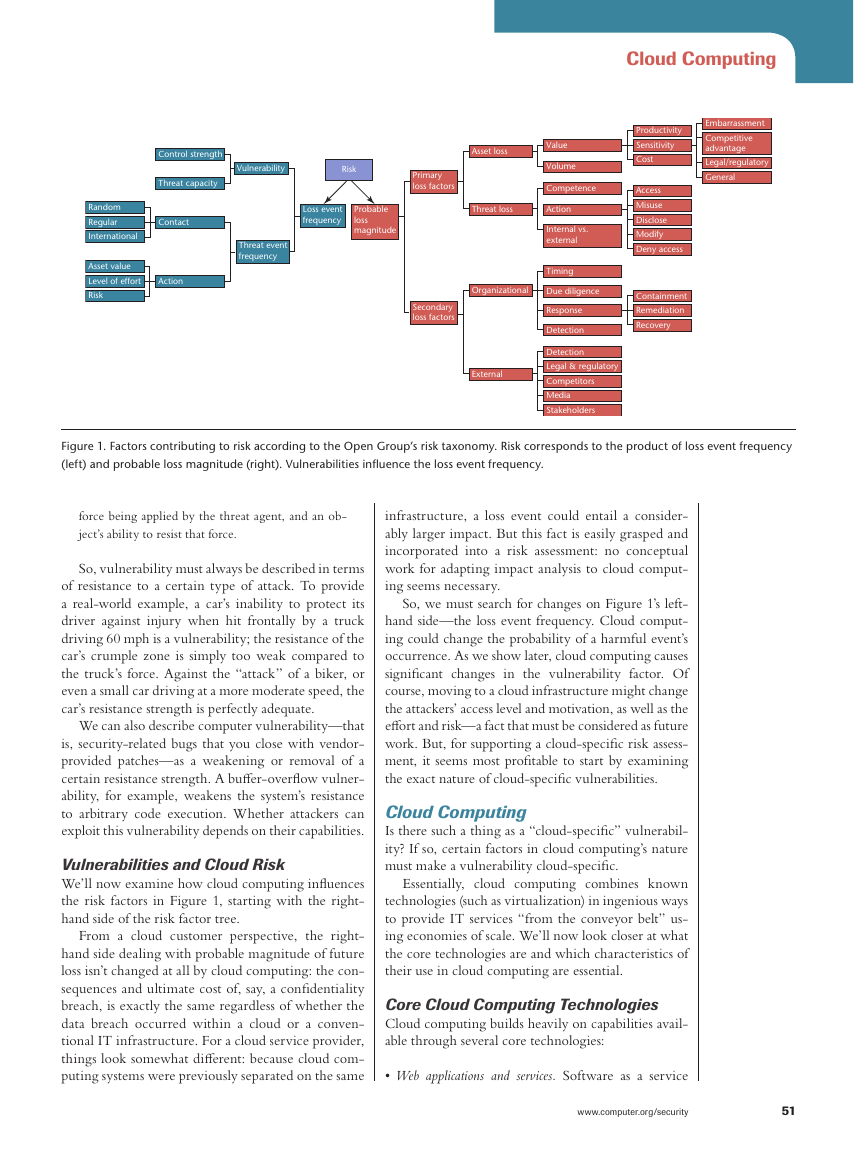
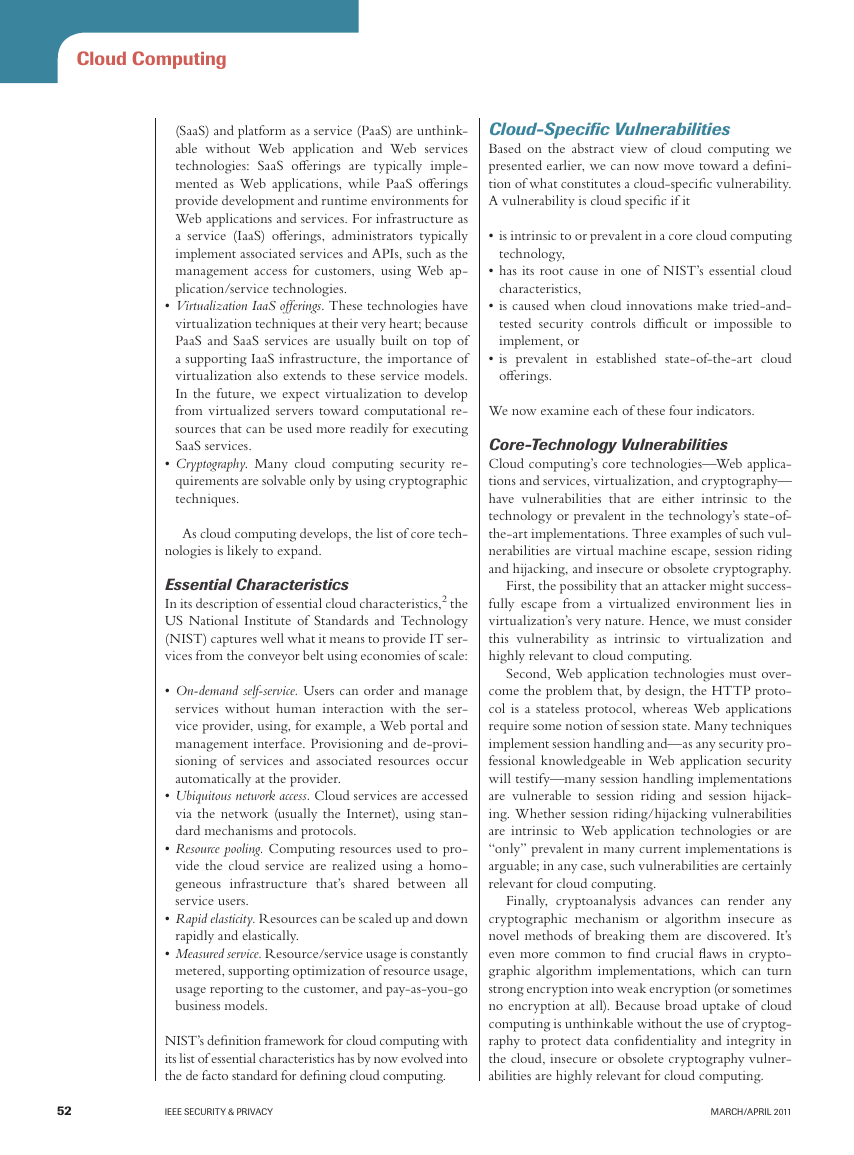
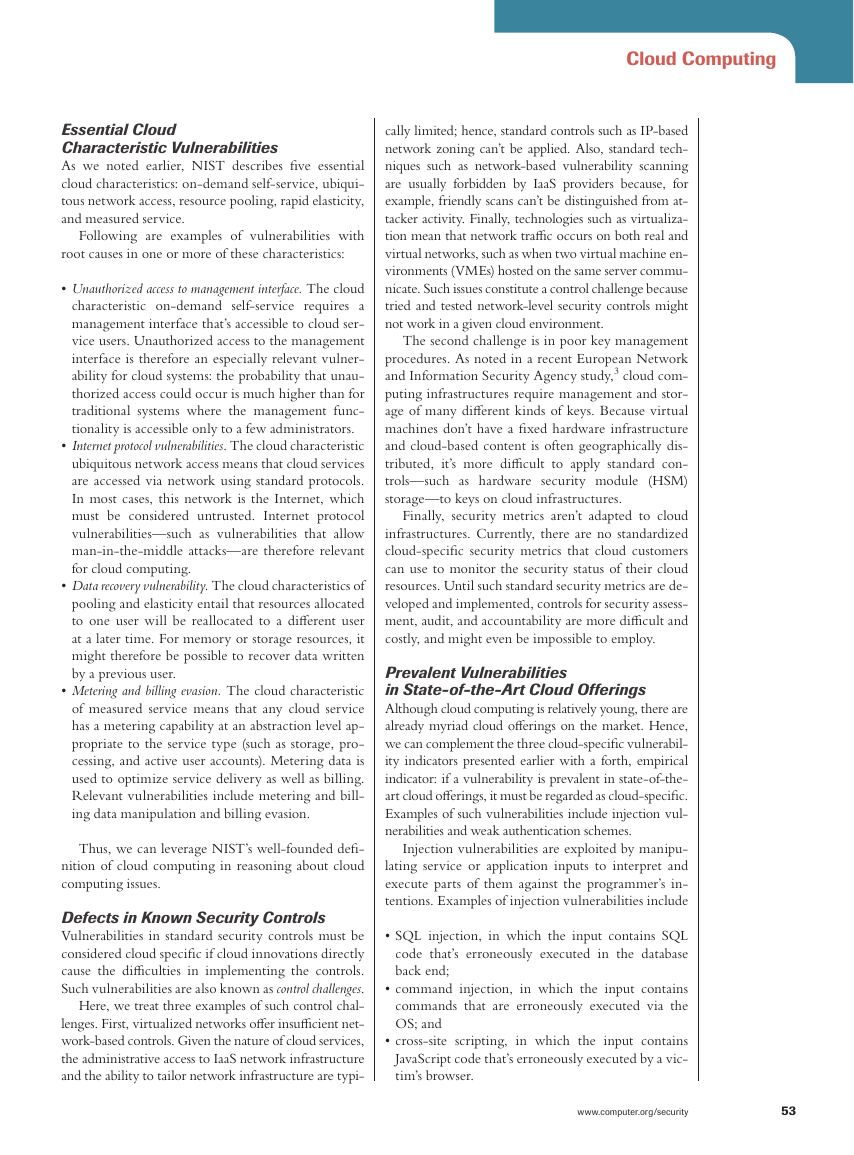
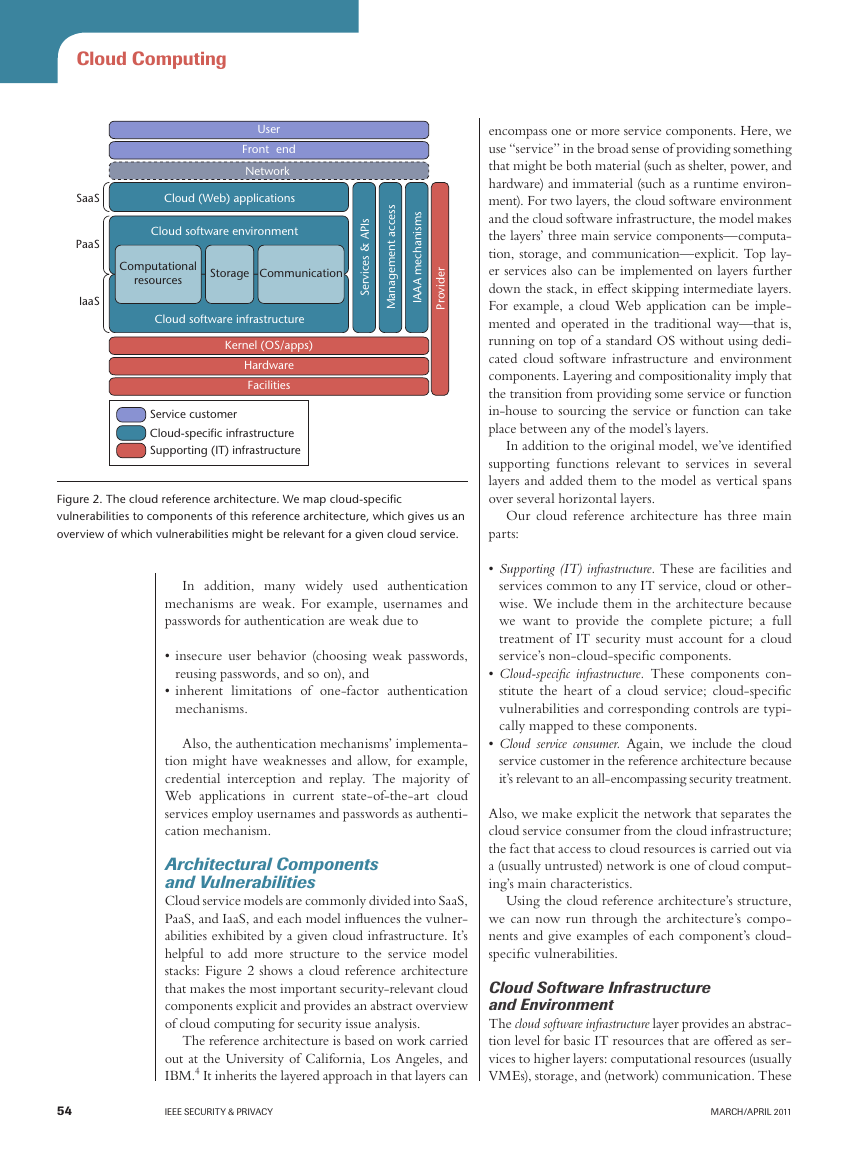
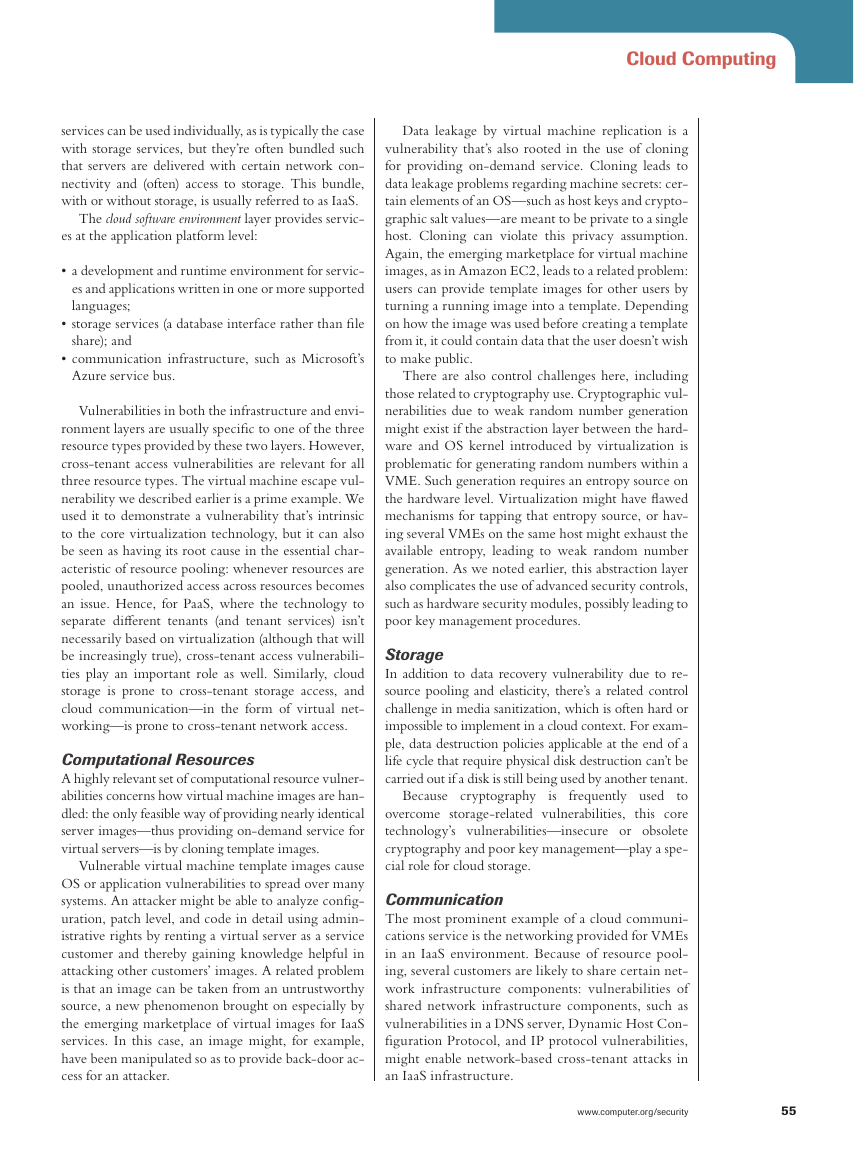
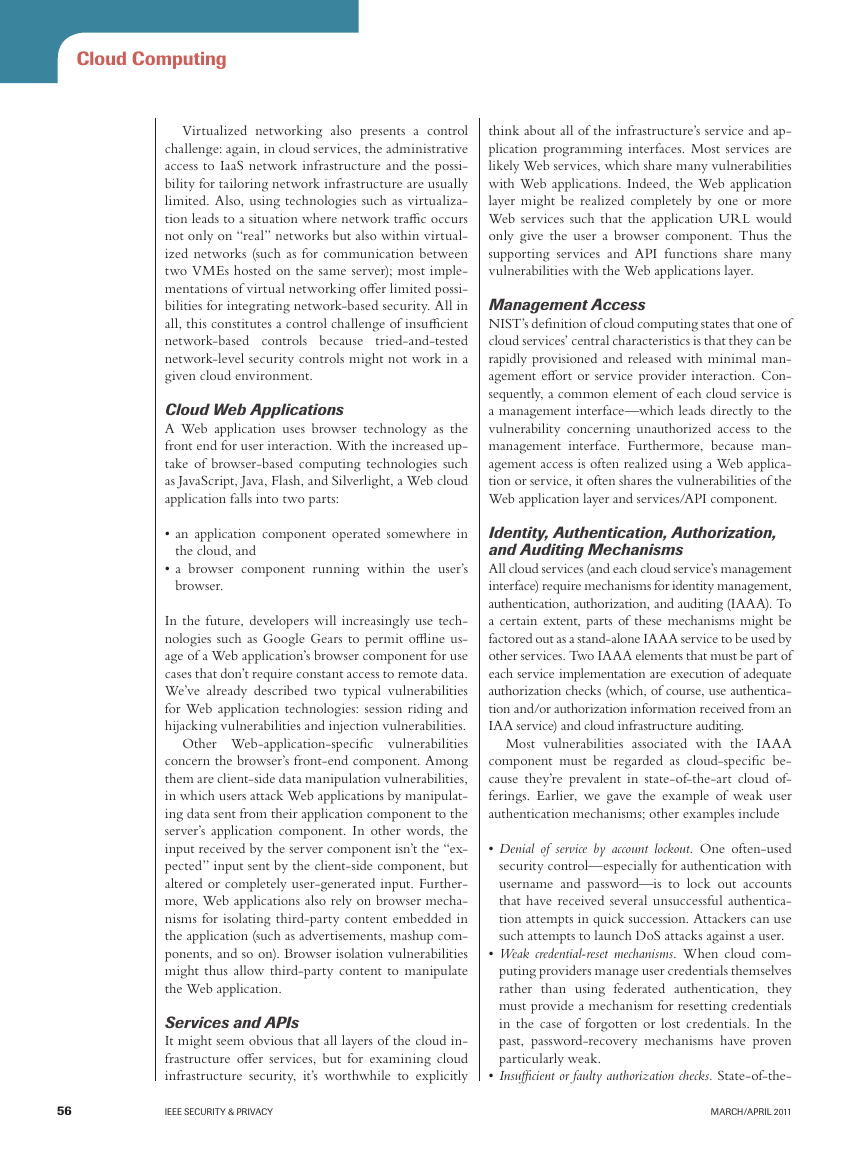
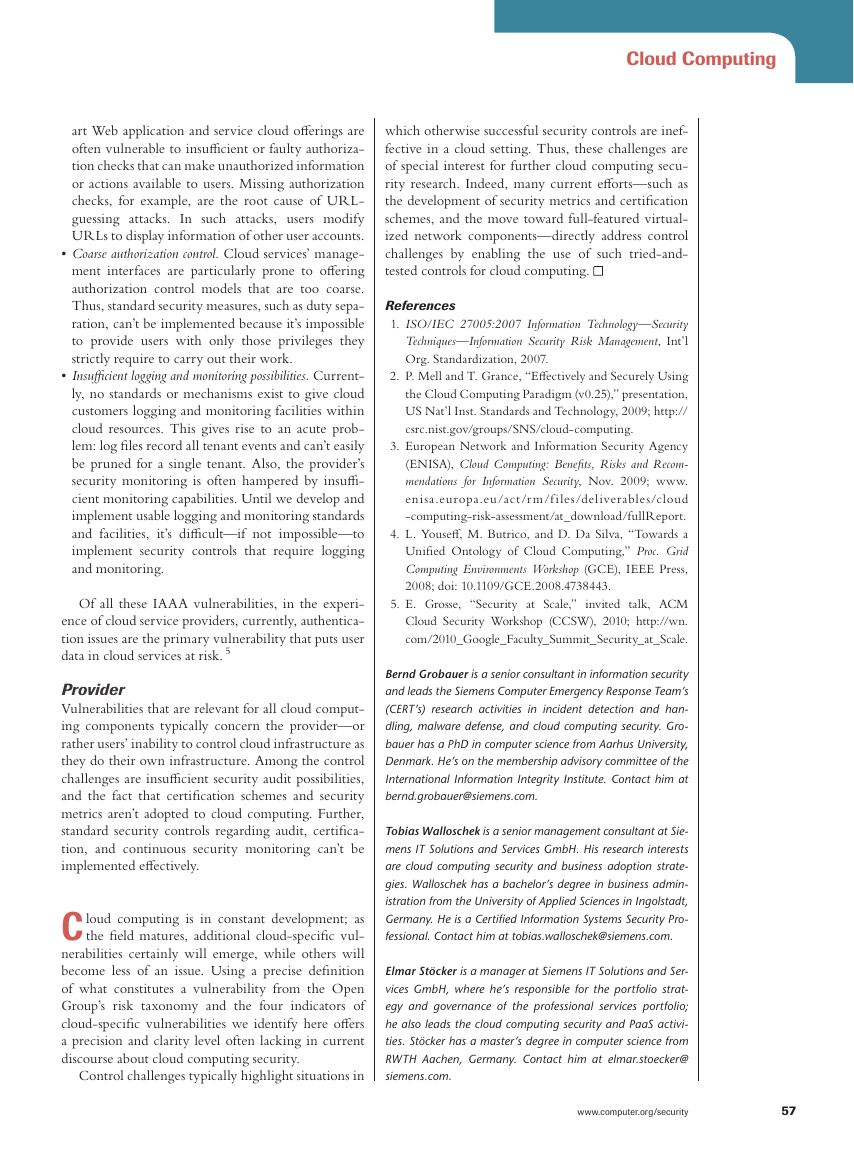








 2023年江西萍乡中考道德与法治真题及答案.doc
2023年江西萍乡中考道德与法治真题及答案.doc 2012年重庆南川中考生物真题及答案.doc
2012年重庆南川中考生物真题及答案.doc 2013年江西师范大学地理学综合及文艺理论基础考研真题.doc
2013年江西师范大学地理学综合及文艺理论基础考研真题.doc 2020年四川甘孜小升初语文真题及答案I卷.doc
2020年四川甘孜小升初语文真题及答案I卷.doc 2020年注册岩土工程师专业基础考试真题及答案.doc
2020年注册岩土工程师专业基础考试真题及答案.doc 2023-2024学年福建省厦门市九年级上学期数学月考试题及答案.doc
2023-2024学年福建省厦门市九年级上学期数学月考试题及答案.doc 2021-2022学年辽宁省沈阳市大东区九年级上学期语文期末试题及答案.doc
2021-2022学年辽宁省沈阳市大东区九年级上学期语文期末试题及答案.doc 2022-2023学年北京东城区初三第一学期物理期末试卷及答案.doc
2022-2023学年北京东城区初三第一学期物理期末试卷及答案.doc 2018上半年江西教师资格初中地理学科知识与教学能力真题及答案.doc
2018上半年江西教师资格初中地理学科知识与教学能力真题及答案.doc 2012年河北国家公务员申论考试真题及答案-省级.doc
2012年河北国家公务员申论考试真题及答案-省级.doc 2020-2021学年江苏省扬州市江都区邵樊片九年级上学期数学第一次质量检测试题及答案.doc
2020-2021学年江苏省扬州市江都区邵樊片九年级上学期数学第一次质量检测试题及答案.doc 2022下半年黑龙江教师资格证中学综合素质真题及答案.doc
2022下半年黑龙江教师资格证中学综合素质真题及答案.doc